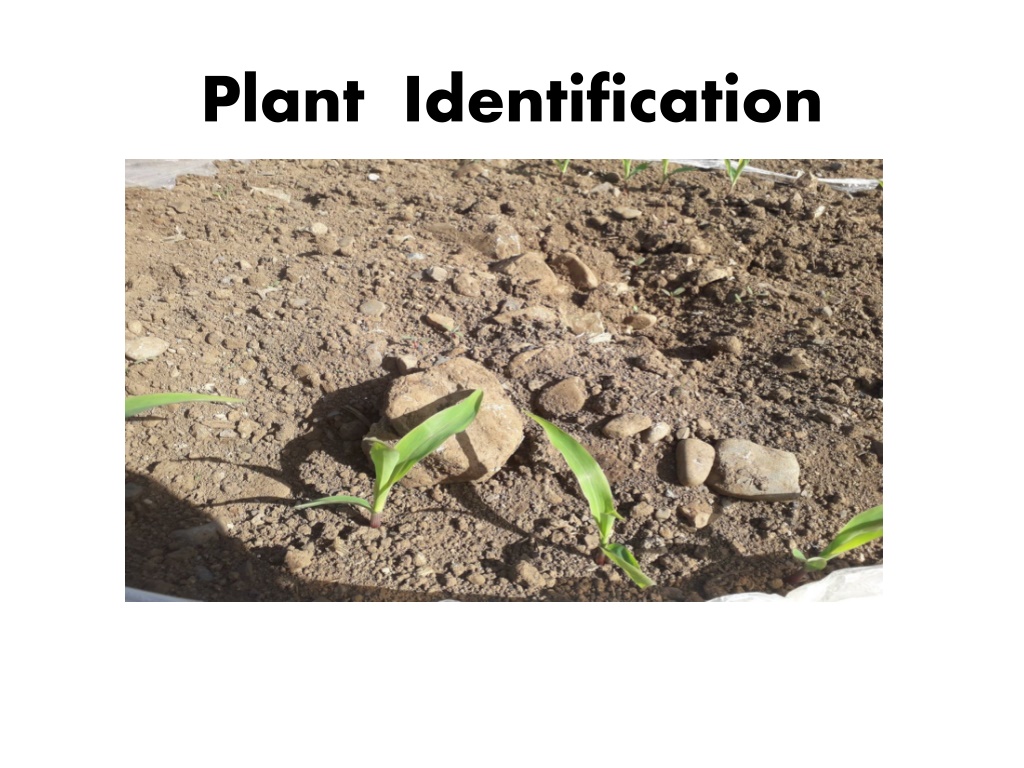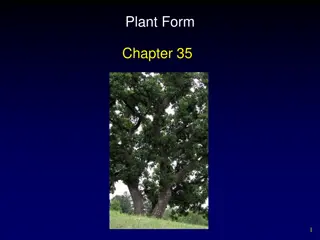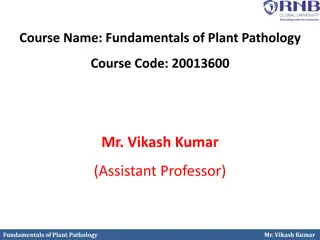Understanding Plant Identification and Families
Plants can be identified by their flowers, leaves, seeds, and habitat. Different plant families like Gramineae, Polygonaceae, and Rosaceae have distinct characteristics. Explore the diverse plant families to learn about their unique features and advantages, such as the importance of Perennial Ryegrass in agriculture.
Download Presentation

Please find below an Image/Link to download the presentation.
The content on the website is provided AS IS for your information and personal use only. It may not be sold, licensed, or shared on other websites without obtaining consent from the author. Download presentation by click this link. If you encounter any issues during the download, it is possible that the publisher has removed the file from their server.
E N D
Presentation Transcript
Plant Identification All plants belong to a particular plant family. Plants can be identified by their flowers, leaves, seed and location. Habitat this is where plants grow. Different plants grow in different habitats. Members of the same families have similar characteristics.
Plant Families Gramineae Family - all grasses and all cereals e.g. Wheat, Barley, Oats, Maize etc. Polygonaceae Family - Docks. Ranunculaceae Family - Buttercups. Umbellifereae Family - Carrots, Parsnips, Celery, Fennel, Cow Parsley, Hog weed. Urticaceae Family -Nettles, Herbs such as mint, sage, basil. Compositeae Family - Daisy, Dandelion, Ragwort, Thistle, Sunflowers, Primulaceae Family - Primroses, Cowslips. Leguminoseae Family - Red Clover, White Clover, Peas, Beans, Legumes, Lucerne, Lupins, Whins or Gorse.
Plant Families Junaceae Family - Rushes. Solanaceae Family - Potatoes, tomatoes, aubergines, peppers. Cruciferae Family - cabbage, Kale, Turnips, Cauliflower, Broccoli, Oil seed Rape. Rosaceae Family - Strawberry, Apple, Cherry, Blackberry, Dog Rose, Chenopodeaceae Family - Sugarbeet, Fodder Beet, Mangels, Beetroot, Fat Hen. Araliaceae Family - Ivy,
Family Gramineae Perennial Ryegrass Gramineae is a very important plant family. Gramineae includes all grasses and cereals e.g wheat, barley, oats, maize etc All members of Gramineae are monocots - this means that they have one seed leaf. Have long narrow leaves and stems may be either flat or round. Grasses have a large root system and can store food reserves allowing grasses to re-grow quickly. Flowers on a grass are referred to as florets and are grouped together in clusters called spikelets. The fruit of a grass flower is called a grain. Perennial Ryegrass is found in well-drained soils with a Ph of 6 or more. Perennial Ryegrass will persist in well managed grassland for many years. Its Infloresence (flower) is easily recognised by the presence of spikelets on alternate sides of the stem. Used in seed mixtures for reseeding land.
Family Gramineae Perennial Ryegrass Advantages of Perennial Ryegrass Very palatable - tasty for animals to eat. Very digestible - converts into meat or milk. High Productivity high yields. High DM (Dry matter) production. DM is the matter remaining in a sample of food after the water has been removed.
Family Gramineae Perennial Ryegrass Long growing season so reduced costs for winter feed. High stocking rate can be maintained because of high productivity levels. Good Tillering ability leads to sward dominance, good ground cover and weed prevention. Tillering is the production of side- shoots. All members of the gramineae family produce tillers (side shoots). This increases the productivity (yield).
Family Gramineae Tillering in a Cereal Crop (wheat)
Family Gramineae Perennial Ryegrass
Family Gramineae Wild Oats Weed in a tillage crop as they compete with a crop for water, nutrients, light and space. Usually only found above the height of a cereal crop. Grow on most soil types. Flower from June to October. Cereals grown for seed must have all wild Oat seeds pulled by hand before they are certified by the Dept. of Agriculture. Considered a Noxious weed under the Noxious weeds Act 1936.
Family Gramineae Wild Oats
Family Gramineae Barley
Family Gramineae Wheat
Family Polygonaceae Docks Perennial - this means that the plant lives for more than two years. Two species of dock -curled dock and broad leafed dock. (Curled Dock is a biennial) Biennial - takes two years to reach flowering stage. All docks affect the productivity of a grassland sward as they compete with grass for nutrients (N.P. K.), sunlight (needed for photosynthesis), water and space. Docks have large tap roots and leaves.
Family Polygonaceae Docks thrive on an open sward and are a problem in pasture used for silage and in pasture that has been overgrazed or poached. Docks produce big clusters of green flowers that turn red when mature. Flowers May to October Large leaves were once used to wrap butter. Docks relieve nettle stings. Flowers are pollinated by the wind but some-times by Bumble-bees. A plant can regenerate from only the roots. Doxstar is a spray used to control docks.
Family Polygonaceae Broad Leafed Dock
Family Ranunculaceae Buttercup Creeping Buttercup, Meadow Buttercup and Lesser Celandine. Indicator species - this means they indicate the type of soil present, poorly drained wet soil. All buttercups reduce the productivity of the sward as they compete with grass for nutrients (N.P.K.), sunlight (needed for photosynthesis), space and water. Buttercups are unpalatable to animals - this means that they are not tasty for animals. Buttercups provide no nutritional value for animals.
Family Ranunculaceae Buttercup Creeping Buttercup: has a bright yellow flower, with 5petals, flowers between May and July. It has hairy leaves and stem. It can reproduce both by seed and asexually by producing runners which can rapidly colonise an area of land. Meadow Buttercup: is a serious weed of older permanent grassland. It has an upright growth habit and can reproduce by seed and asexually from an underground rhizome. Flowers from May to July. The whole plant is poisonous with acrid sap that can blister the skin. It is therefore avoided by grazing animals. All Buttercups are important for Biodiversity as they attract bees and other insects.
Family Umbelliferae Cow Parsley Cow parsley, Carrots, Parsnips, Parsley. Cow parsley is a common weed with a white flower found along field edges and in hedgerows. Umbel: the infloresence is called an umbel which consists of a number of short stalks with small white flowers that all originate from the same point. Cow parsley has no nutritional value for farm animals and they rarely eat it. Cow Parsley is important for Biodiversity. Biodiversity: all living organisms in an ecosystem, this includes plants, animals and micro-organisms.
Family Umbelliferae Cow Parsley
Family Urticaceae Nettle
Family Urticaceae Nettle Found in hedgerows and in wasteland. Nettles grow in rich soils especially those manured by animals and rich in Nitrogen and Phosphorus. Often found around old ruins and their presence in large clumps away from buildings in woods or fields may indicate former human habitation. Nettle stems are a good source of fibre. Nettle leaves are a good source of iron and are often cooked with cabbage.
Family Urticaceae Nettle Caterpillars of several butterflies feed on the leaves of nettles as the sting from the nettle will prevent other predators from eating the caterpillars. Flowers are male and female on seperate plants and have tiny greenish hanging clusters. Flowers occur in circles around the stem. Leaves are simple and have hairs or sometimes scent glands.
Family Compositeae Daisy, Dandelion,Thistle, Ragwort, Sunflowers The flower head of members of the compositeae family are composed of many individual flowers and they all share the same receptacle. Seed dispersal is by the wind Ragwort: is a poisonous weed to cattle and horses, sheep can tolerate some ragwort. Ragwort is a biennial plant. In the first year ragwort can be identified as a rosette. Rosette is a cluster of leaves in a circular form. In the second year ragwort produces yellow flowers from June to November which produce thousands of seeds. Seeds are mainly dispersed by the wind. Ragwort grows extensively in grassland. Ragwort is listed under the noxious weeds act 1936.
Family Compositeae Daisy: found in lawns and short grassland from March to October. Each daisy flower is on a slender stalk and has a yellow centre of disc florets surrounded by white ray florets which sometimes has a hint of pink on the edges. Leaves are spoon shaped and grow in rosettes very tightly into the ground so that nothing else can grow beneath them. Daisies are of no nutritional value to animals and they compete with grass for nutrients (N.P.K.), sunlight, space and water. Daisies are important for Biodiversity and attract insects such as bees for pollination.
Family Compositeae Dandelion: grow anywhere that is open and grassy. Dandelions are considered weeds by farmers as they compete with grasses for nutrients (N.P.K.), sunlight, water and space. Dandelions are biennials with a very deep tap-root so they are very difficult to get rid of in a field. Dandelions have a yellow flower which comes out from March to October. The leaves form a rossette and the reddish stem is weak and hollow. Dandelions are a useful plant as: (a)Leaves can be used in a salad (b)Flowers can be used to make wine (c)Roots can be used to make a drink like coffee used in central and eastern Europe (d)During the second world war the milky sap from the dandelion was to make rubber in the Soviet Union.
Family Compositeae Thistle: the flower heads of these plants are composed of many individual florets and all share the same receptacle. Individual flowers are so densely arranged that they resemble a single flower. Leaves are fiercely spiny and hairy with spiny wings. Thistles grow in pastures, hedgerows, wasteland, neglected gardens, disturbed ground and along roadsides. Wind is used to disperse the seeds of the thistle. The thistle has a purple flower that has an egg shaped head and is in flower July to October. The thistle is good in a wildlife garden as it attracts many insects such as bees, butterflies and other insects and this encourages biodiversity.
Family Primulaceae Primrose (known more commonly as Mayflower) and cowslips. Perennial plant with rosettes of leaves and numerous flowers on slender leafless stalks. Flowers are pale yellow with a darker centre, fragrant, sepals forming a bell shape. Found in well drained soils in woodlands, old pastures, on grassy banks, and on ditches. Primroses have a scent and bright colour so attract bees and other insects for pollination. Primroses flower from February to March. Primroses are often crossed with cowslips when they are growing near each other and they produce flowers with stronger stems like the cowslips but flowers like the primrose.
Family Leguminoseae Leguminoseae family also known as the fabaceae or pea family. Red Clover and White Clover are very important agricultural plants. (Also Lucerne) Red Clover and White Clover contain Rhizobium Bacteria which live on the root nodules of the clover plant (p.58 book) Rhizobium Bacteria fix nitrogen from the atmosphere into nitrates that the plant can use. Symbiotic Relationship (Symbiosis): This is when two different species exist together each for mutual benefit. The Rhizobium bacteria and the clover plant is an example of a symbiotic relationship.
Family Leguminoseae The Rhizobium bacteria fix nitrogen into nitrates that can be used by the plant and in return the plant gives the bacteria a place to live on the roots and also food. The root nodules are a source of starch (carbohydrate) for the Rhizobium bacteria. Peas, Beans, vetch, legumes, whins (gorse) belong to this family. Also Lupin flowers belong to this family.
Family Leguminoseae Red Clover
Family Leguminoseae Red Clover Perennial Plant - it lives longer than two years. It re-grows every year from the root producing flowers and seeds. Has a red/pinkish flower. Flowers from May to October. Flowers attract bees as flowers are a good source of nectar. Flowers are insect pollinated. Fixes Nitrogen (Symbiotic Relationship) Has hairy leaves and Stems. Grows along roadways, fields,
Family Leguminoseae Red Clover Advantages of Red Clover Highly digestible -this means that a high proportion of the red clover consumed is assimilated and used by the animals body. Very productive - it provides a high yield of silage and can be cut a number of times in a season. Very palatable - this means that it is tasty for animals to eat. Fixes Nitrogen.
Family Leguminoseae White Clover
Family Leguminoseae White Clover Perennial Plant - lives longer than two years. It re-grows every year from the root producing flowers and seeds. Has a White Flower. No hairs on stems / leaves. Smaller plant than red clover. Fixes Nitrogen (Symbiotic Relationship) Used in seed mixtures
Family Leguminoseae White Clover Produces stolons - so it spreads quickly within a sward. The stolons take root when they are trampled into the soil and this provides good ground cover preventing weed establishment. Stolon: is a form of vegetative reproduction whereby a branch of the parent plant produces roots when it comes in contact with soil and a new plant develops.
Family Leguminoseae White Clover Advantages of White Clover High in Protein - protein is needed for growth and repair of cells. Fixes Nitrogen. Highly Productive - high yields (amounts). Highly Palatable - tasty for animals
Family Leguminoseae Differences between Red and White Clover White Clover Red Clover Short Plant. Creeping growth habit. No hairs on leaves or stems. Has Small leaves. Good at fixing nitrogen. Good quality. Persistent. Red / Pink Flower A taller plant. Erect Growth habit. Hairs on leaves and stem. Large leaves. Not as good at fixing nitrogen. Not as good quality. Not as persistent. White Flower.
Family Leguminoseae Vetch
Family Leguminoseae Vetch Pink Flowers. Narrow leaflets. Black seed pods. Fixes Nitrogen. Climbing Perennial plant - lives longer than two years. It re- grows every year from the root producing flowers and seeds. Attracts insects such as bees for pollination so also adds to the Biodiversity of an area. Considered a weed by farmers as it is of no nutritional value to animals, however would add some nitrogen. Bush vetch is most common found growing along roadsides, hedgerows and lanes. It has tendrils which help it to climb. Flowers May to August.
Family Leguminoseae Whins / Broom / Gorse
Family Leguminoseae Whins / Furze / Gorse Rich Yellow Pea flowers. Leaves are modified into rigid and furrowed thorns that withstand the harsh conditions of winters. The bush is a mass of thornes which helps to keep animals away from it. Found in Hedgerows, fields, along roads. Flowers March to October. Can grow 1metre to 3metres tall. On warm days the flowers scent the air with vanilla and coconut fragrance. Gorse was used to clean chimneys in the past. Gorse was used as a primitive harrow in early farming. The farmer would pull a gorse bush across ploughed land.
Family Junaceae: Rushes Rushes are found growing in wet areas. Rushes are an Indicator Species: this means that they indicate the type of soil and habitat present. Wet soil + a wet habitat. Rushes are of no nutritional value to farm animals. Rushes compete with grass for light, nutrients, space and water. Rushes can be sprayed with a herbicide to kill them. Rushes can be cut and dried and used for bedding farm animals. In the past rushes were used for thatching houses.























